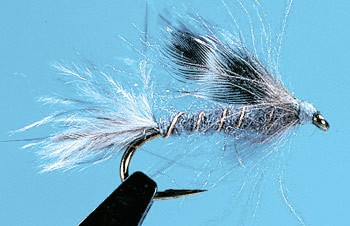
On The Fly
"Fly tying is a school from which we never graduate"
TYING NEWS
The Southern Oregon Fly Tiers met Tuesday, May 8th, at
the Madrone Hill community building near Gold Hill. This location is going
to work out great for our club meetings each month. There is plenty of room
for more tiers. We encourage novice and experienced tiers alike to drop by
the second Tuesday of each month for a fun evening. The next meeting will
be on Tuesday, June 12th, starting at 7 p.m.
Iím sorry that I missed submitting an On The Fly article
in last monthís newsletter. My travel schedule and our kitchen remodel
caused me to miss the deadline. So many flies, so little time.
 PATTERN OF THE MONTH - Timberline Emerger
PATTERN OF THE MONTH - Timberline Emerger
Hook: Long-shank wet-fly, sizes 6 Ė 12.
Thread: 8/0, color to match body.
Tail: Marabou, in olive, brown, black or gray.
Body: Shaggy dubbing such as Angora or seal substitute,
color to match tail.
Rib: Copper wire.
Collar: Neck hackle, color to match body.
Wings: Two grizzly hen hackles.
Tying Instructions:
1) Start the thread one eye length behind the eye. Wind a thread base back
to just above the barb of the hook.
2) Tie in a clump of marabou on top of the hook to form a one-shank-length
long tail. Tie in the copper ribbing wire and pull it back out of the way.
3) Form a dubbing loop with the thread and insert the shaggy dubbing
material then twist the loop to form a dubbing rope. Wind the dubbing rope
forward to create a tapered body. Tie off.
4) Counter-wrap the copper wire in four even-spaced turns. Tie off.
5) Tie in the hackle by the tip and wind it forward in three turns to
create the collar. Tie off.
6) Select two matching grizzly hen hackle feathers and prepare them so the
tips reach the base of the tail. Tie them in back-to-back and curving out.
7) Form a thread head, whip-finish and apply head cement.
The Timberline Emerger was developed by Randall Kaufman
in the mid 1960s to tempt finicky trout in the High Sierra backcountry
timberline lakes. Randall found that what looked like surface activity was
actually subsurface feeding on emerging insects. The dry fly approach was a
waste of time and the wet flies of that era seemed to turn the fish away.
After much experimenting through trial and error, what was to be named the
Timberline Emerger, succeeded with dramatic results. It consistently took
trout over many years and is still popular. Success can be contributed to
the natural grizzly hen hackle tip wings. Their subtle barring along with
their soft, water-absorbing quality and wide outline seem to be a winning
combination. This pattern is not an exact imitation of the caddis pupa or
hatching mayfly, but it is of reasonable size, shape and color to fool many
trout. You should let the Timberline Emerger sink to the feeding depth and
use a slow, hand-twist retrieve: this is the key to hooking up with trout
in the lakes of our own Cascades. So, tie some up, give them a test flight,
and let me know how you do.
TYING TIPS
The Timberline Emerger is moderately easy to tie and uses
common materials. It is important to leave enough space behind the head
area for the hackle collar and wings to be tied in without crowding. The
angle and length of the hackle should also be noted to maintain proper
proportions. Hackle tips should extend back to the point of the hook and
the angle should be 45 degrees. In this case the hackle represents legs and
should be kept sparse, too much can affect sinking and swimming qualities.
Tie One On,
Dan Kellogg (you can contact me at FLYGUY@EZNORTHWEST.COM)